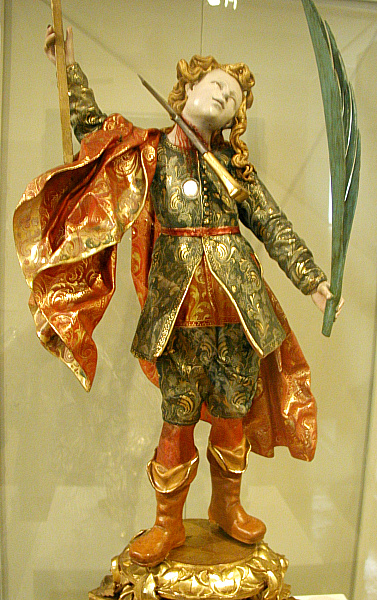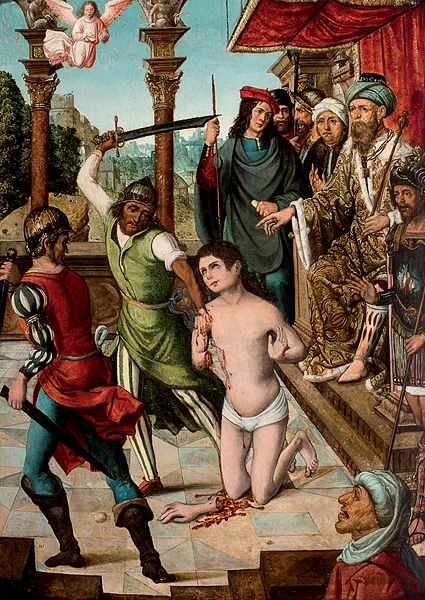The saint is consistently portrayed as a young person, because he was martyred at the age of 13. His story was first told by a Cordoban priest named Raguel, who lived in the 10th century at approximately the same time as the boy. Later in the same century it was rendered into a poem by Hrotsvitha of Gandersheim. The major difference between the two accounts is that Raguel has the boy cut into pieces, which are then thrown into the river, whereas Hrotsvitha says he was catapulted into the river from the city wall, his body then shattering into pieces. Artists consistently follow the former account, as in the third image at right.
In the art Pelagius is customarily presented as a beautiful youth, his beauty being an integral part of his story. He was in prison in Muslim Cordoba as hostage for his kinsman, a Galician bishop, when accounts of his youth and beauty reached the Caliph. This ruler already had a collection of catamites, and he ordered them to persuade Pelagius to deny Jesus and become one of them. But the boy steadfastly refused. When he recoiled from the Caliph's touch the latter flew into a rage and ordered his death.
In Raguel the boy continues to pray even while his limbs are being removed. At the end God calls to him, "Come, accept the crown which I have promised you from the beginning." The third image at right expresses the boy's prayerful attitude, and the angel arriving from above symbolizes God's words.
Prepared in 2015 by Richard Stracke, Emeritus Professor of English, Augusta University

St. Pelagius in the Church of San Paio, Santiago de Compostela (See description page)
In Galicia (See description page)

The Martyrdom (See description page)
ATTRIBUTE
- Sword cutting his neck
MORE IMAGES
- 17th century: In the so-called Martyrdom of St. Anthony the martyr pictured is probably St. Pelagius.
DATES
- Feast day: June 26
- Pelagius was killed in 925 at the age of 13
NAMES
- Known as San Pelayo in most of Spain
- In Galicia, San Paio
BIOGRAPHY
- Raguel's vita in English translation is in Head, 227-35.
- An English translation of Hrotsvitha's poem is in Wiegand, 129-57.
- In Latin, the Acta Sanctorum (June vol. 5, 204-225) has Raguel's vita, Hrotsvitha's poem, and the Mozarabic Office for Pelagius's feast day.